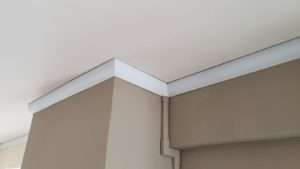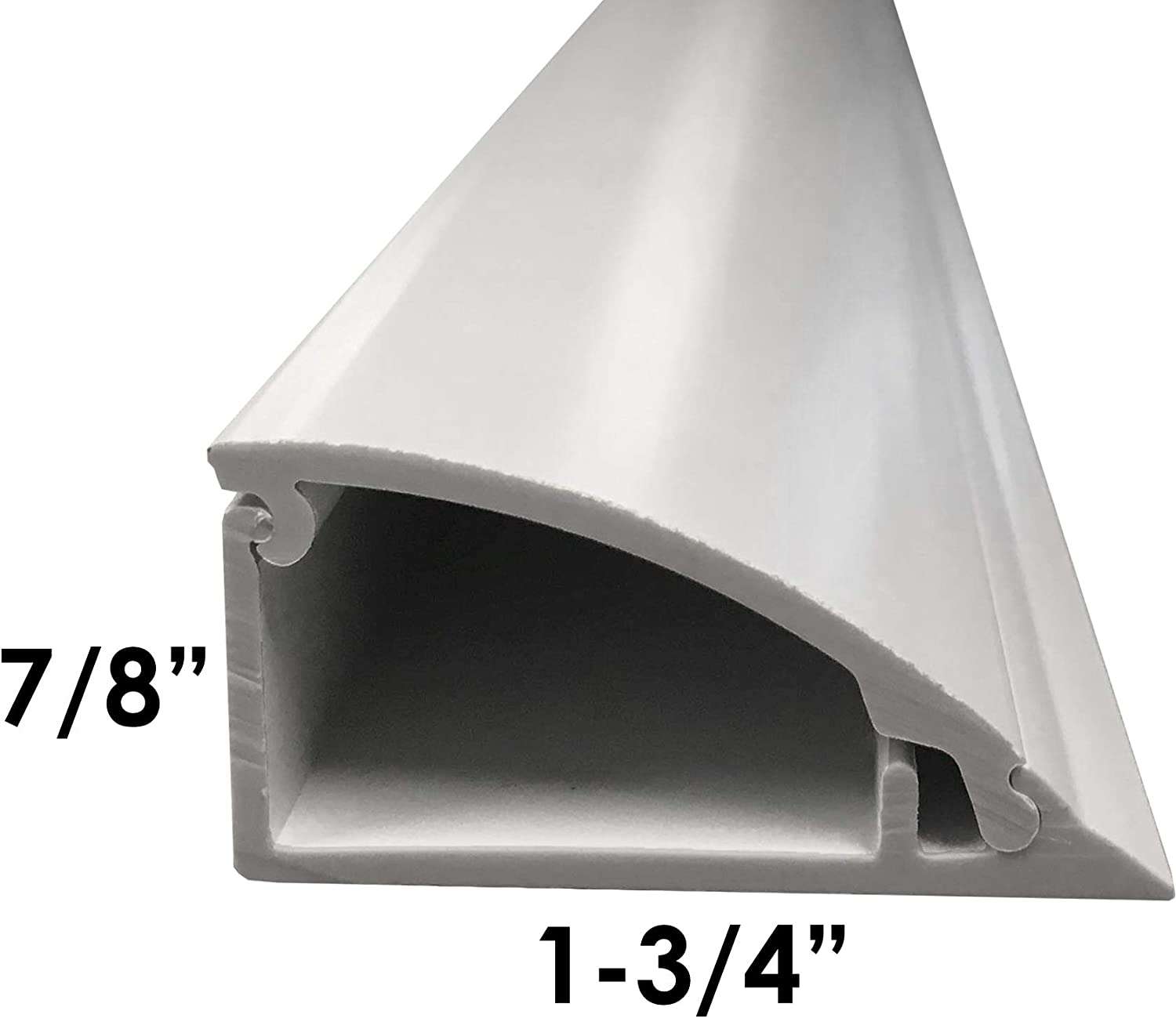This post may contain affiliate links which means I may receive a commission for purchases made through links.

Exposed wires on the ceiling make the room decor look unattractive and distracting. Moreover, exposed wires compromise the safety of your home’s wiring as they can lead to potential accidents. Luckily, there are various ways you can use to hide these cables and enhance the room’s aesthetics. One such technique is using crown molding to hide wires in your home’s ceiling.
But, how exactly do hide electrical wires with crown molding? Well, in this post, I’ll show you how to hide any unsightly wires on the ceiling using trim. In addition, I’ll take you through some creative and simple alternatives you can use to hide exposed wiring from speakers, TVs, or light fixtures if you’re not a fan of crown molding!
Using crown molding to hide exposed electrical wiring
There are many ways to use crown molding in your home. In most cases, crown molding is mainly used to hide the intersections of ceilings and walls. Thanks to its ability to add a decorative flair, while hiding visible gaps between the room’s structure.
However, you can also use crown molding to hide electrical wires, while giving your home a unique look. This is because most crown molding styles have space above and behind them that can accommodate electrical wires. Alternatively, you can simply place the cables along the edges at the back of the crown molding. This will give you a sleek, minimalistic aesthetic by hiding all the messy wires and cords in the room.
Moreover, if your house already has crown molding, you can remove them, put the wiring between the ceiling and the walls, and reinstall the molding.
Step-by-Step guide on how to use crown molding to hide electrical wires
This technique of hiding electrical wires requires specialized crown molding with a hidden channel for running the cables. More notably, this specialized type of molding features a track that you can attach to the wall 3” from below the ceiling using screws.
Luckily, many popular brands manufacture this type of crown molding. Once you’ve found the best type of crown molding for hiding electrical wires, follow the steps below to install it!
Steps
- First, turn off the power at your circuit panel and check with a voltage tester to ensure that the power is completely off.
- Next, snap a chalk line 3” from the ceiling around the room. This line will act as a guide for mounting the molding track during crown molding installation.
- Secure the crown molding track by inserting a screw every 3 ft using an electric drill/ screwdriver and fasteners.
- Use a spade bit to drill a hole in the molding track above an existing power outlet. This will allow you to fish the wires from the existing power outlet to the new molding track.
- Fish new cables and wires from the existing power outlet through the hole in the molding track and screw the wire with a zip tie every few feet to secure it in place.
- Drill another hole into the track using a spade bit when you’re ready to add a new outlet and cut out the outlet hole with an oscillating saw.
- Fish 2 sets of wire to the new outlet hole and drop them down into the wall where the new outlet will be. One wire will continue supplying power to the other outlets on the circuits, while the other will supply power to the new outlet.
- Install the new outlet and use a flexible putty to seal the holes on the track.
- Measure the lengths of your crown molding, subtract for the prefabricated corners and make a straight cut with your miter saw.
- Now, install your crown molding pieces and the prefabricated corner pieces to hide the wires from view.
- Once the molding is in place, make the proper wire connections at each outlet. Specifically, connect the black hot wires to brass screws and the neutral white wires to the silver screws. For the ground wires, tie them together and connect them to the ground screw on your outlet.
- Cover your outlets with an outlet plate and turn the power back on!
Alternative ways to hide wires in the ceiling
-
Paint electrical wires
If installing crown molding seems too much to handle or way beyond your budget, you can try the simple alternative of painting the wires. Painting your wires with the same color as the ceiling will make them hard to identify from the rest of the surroundings. At the same time, this allows you to easily hide exposed wires with minimal effort since it doesn’t involve any installation.
However, you’ll need simple materials like tacks, staples, or clamps to hold your electrical wires in place. Next, look for water-based paint and use a paint sprayer to paint the exposed wiring and the materials keeping them in place for easy coverage. In some instances, you’ll need to apply more than one paint coat to get the desired results for your wiring.
For safety reasons, make sure you wear protective gear such as protective eyewear, gloves & a mask. Also, put a tarp down before you apply the paint and avoid painting over any switches or outlets.
-
Use Cord concealer covers
Cord covers/ cable raceways are plastic tubings that are relatively affordable and quite easy to install. Even better, they’re available in various sizes and lengths to fit the electrical needs of any home.
To install cord covers, first drill them to create a path for your electrical wires. Alternatively, you can use double-sided tables to adhere the cover to the wall, but that will depend on the type of paint texture in your home. More importantly, make sure you choose cord covers whose color and design will easily blend with your home’s decor. In addition, remember to clean and dry the wall or ceiling surface before you install the cord covers.
Once you’ve attached the cord concealer covers onto the ceiling/ wall, run cables through the tubes and swipe the cover to hide the wires.
-
Cover grouped wires with a ceiling box
If you’ve got a group of wires on the ceiling that needs to be hidden, consider covering them with a ceiling box to conceal them. Similar to cord covers, look for a ceiling box that will blend into the ceiling paint. However, you can also use them to create colored accents for the room.
One benefit of using a ceiling box is that it doesn’t show the screws after installation, thus giving your ceiling a clean look. Plus, they’re safe to paint, allowing you to match their color with the ceiling paint before installation.
-
Run electrical wires through ceiling holes
Lastly, you can simply cut or drill small holes in your ceiling and run your cables through the room without exposing them. However, this option may not be suitable for all homeowners. Other than that, it’s an incredible way to keep your room uncluttered and wire-free.
Final Word
Using crown molding to hide electrical wires is a great technique. Moreover, the crown molding will offer other benefits like enhancing your home’s decor and aesthetic. Alternatively, if the cost of installing crown molding is too high for your budget, consider using the other options I’ve mentioned above.
One thing you need to note though is that dealing with electrical wires can pose some safety risks. So, if you’re not comfortable doing the task yourself, consider hiring a professional to do it for you!
